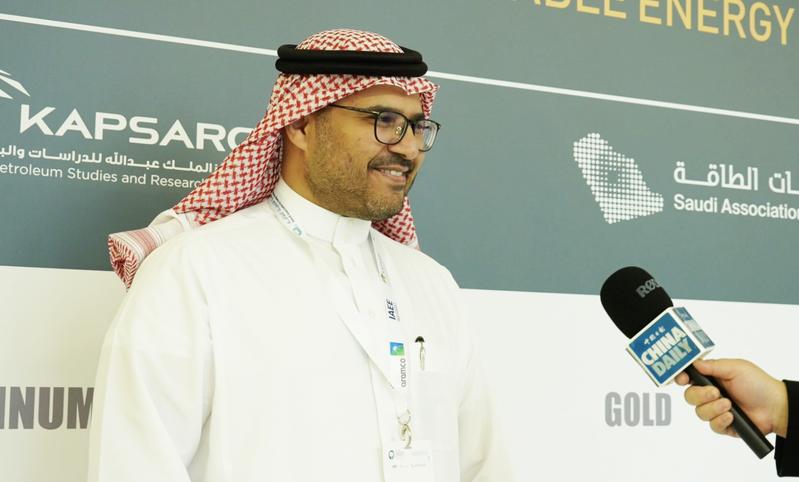 Fahad Alajlan, president of the King Abdullah Petroleum Studies and Research Center, or KAPSARC, speaks to China Daily on Feb 5, 2023 in Riyadh. (LIU XIAOHAN / CHINA DAILY)
Fahad Alajlan, president of the King Abdullah Petroleum Studies and Research Center, or KAPSARC, speaks to China Daily on Feb 5, 2023 in Riyadh. (LIU XIAOHAN / CHINA DAILY)
Amid a long list of Saudi projects keeping tabs on the challenges confronting the Arab nation’s energy transition, the head of a Riyadh-based think tank said they are looking to China for greater collaboration to build on the development momentum.
“I think the ambition of the Chinese BRI (Belt and Road Initiative) and the Vision 2030 of Saudi Arabia align very well,” Fahad Alajlan, president of the King Abdullah Petroleum Studies and Research Center, or KAPSARC, told China Daily on the sidelines of the 44th International Conference of the International Association for Energy Economics, or IAEE, that kicked off in Riyadh on Feb 4 and will run until Feb 9.
I think the ambition of the Chinese BRI (Belt and Road Initiative) and the Vision 2030 of Saudi Arabia align very well. If you look at BRI, for example, there is a lot on supply chain, there is a lot of infrastructure, and this is the same that we see in Vision 2030. Both set a very ambitious target, but also I think both aim to be regional centers of logistics, of infrastructure, of expert and localization and globally.
Fahad Alajlan, president of the King Abdullah Petroleum Studies and Research Center
“If you look at BRI, for example, there is a lot on supply chain, there is a lot of infrastructure, and this is the same that we see in Vision 2030. Both set a very ambitious target, but also I think both aim to be regional centers of logistics, of infrastructure, of expert and localization and globally,” he added.
Saudi Arabia has been keen on topics ranging from climate science, energy price reform, economic efficiency and investments.
During the first half of 2022, Saudi Arabia became the largest recipient of Chinese investments under the BRI, with about $5.5 billion in investments, according to the Shanghai-based Green Finance and Development Center.
During his headline-dominating visit to Riyadh in December last year, Chinese President Xi Jinping upgraded strategic partnership in development of ties with Saudi Arabia.
Alajlan said the relationship between China and Saudi “has evolved dramatically over the past three decades”, making China the biggest trading partner for Saudi Arabia. So the beneficial and cooperative arrangement between the two countries “makes sense”.
“But that has moved beyond just being an energy importer or an energy exporter. I think it has evolved into more strategic cooperation that looks at different perspective of the energy question — whether we’re talking about the energy supply chain …on the technology front, on the collaboration front, also on the climate change front,” said Alajlan.
Alajlan said that both countries’ visions were “outward-looking, not just onward looking” and so they “envision themselves within the regional cooperation but within the global order”.
And as China “becomes a dominant technological player, especially in clean energy”, given advancements in industries such as solar panels, lithium batteries and electric vehicles, “cooperation is moving into the next level”, the KAPSARC president said.
“We’ve seen ... Saudi Arabia and China continue to work together and build on these ambitions, so the alignment between the BRI and Vision 2030 is very symbiotic and is actually helping both countries achieve their visions,” said Alajlan.
China and Saudi Arabia have both announced their goals to reach net-zero emissions by 2060. Saudi Arabia has launched its Middle East Initiative and the Saudi Green Initiative to facilitate this vision.
ALSO READ: Oracle to invest $1.5b in Saudi Arabia, eye data center in Riyadh
KAPSARC and the Saudi Association for Energy Economics are hosting the six-day 44th IAEE international conference, being held for the first time in the Middle East and North Africa region. Alajlan said it marked a “very important timing” as Egypt had recently hosted the COP27 climate conference and the United Arab Emirates is gearing up to host COP28 this year.
Alajlan said the IAEE conference is “giving the region a voice in this important discussion around energy transition, around energy trilemma of managing energy security, energy affordability and the challenge of climate change”.
“So, it’s very important that we’re bringing everybody globally here to be in Riyadh to actually experience Riyadh and to experience this discussion from a different perspective — which is not always given a voice, especially in media — which is the emerging economies, the developing countries’ perspectives,” said the KAPSARC president.
“I think in most media outlets, we hear about the perspective of developed countries, especially in North America and Western Europe,” he added.
READ MORE: Riyadh conference sees Saudi shift to green energy exports
After the IAEE conference, Alajlan said his organization will keep pushing projects on the Saudi domestic front, involving energy price reform and energy efficiency, including investments in oil and gas, renewables and hydrogen; and that they will also look globally, given the challenges of energy transition.
“So we’re doing a lot on climate science, on climate policy, on issues that are … (related to) the energy transition. What are the needs when it comes to minerals and metals that are needed to fuel the energy transition. And we’re hopeful that we continue to collaborate globally, especially with China and India that would help us,” he added.
Contact the reporters at jan@chinadailyapac.com


